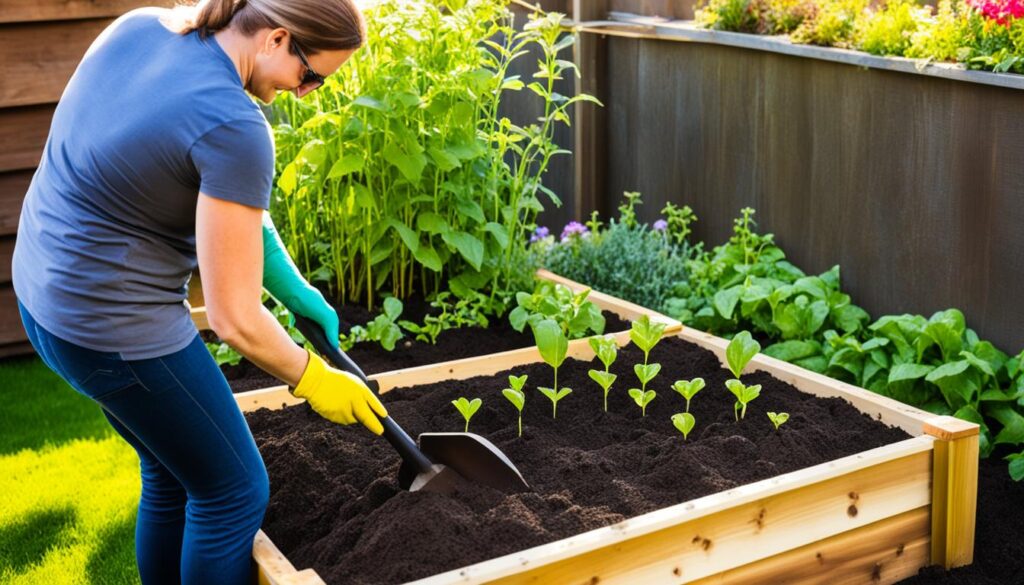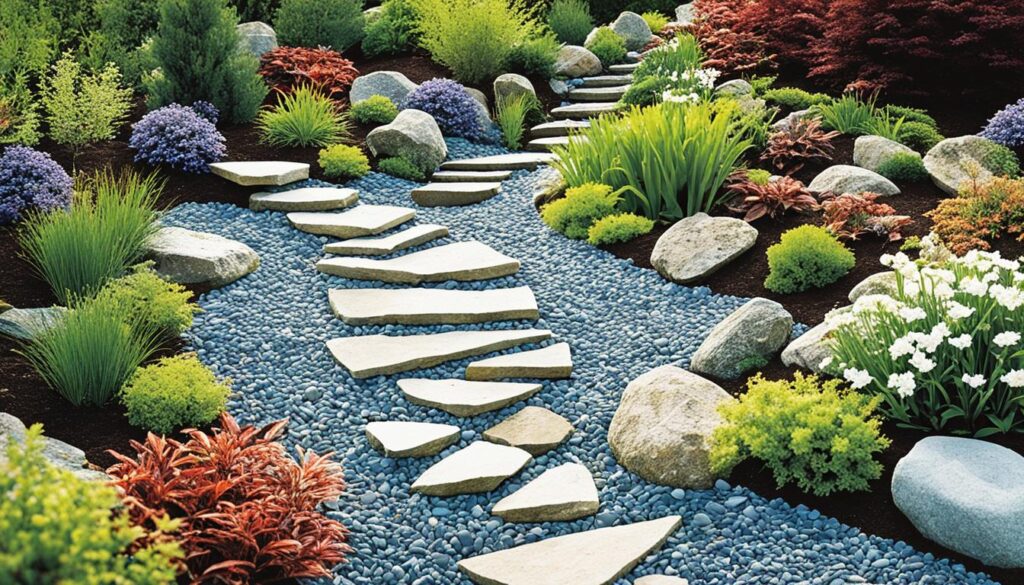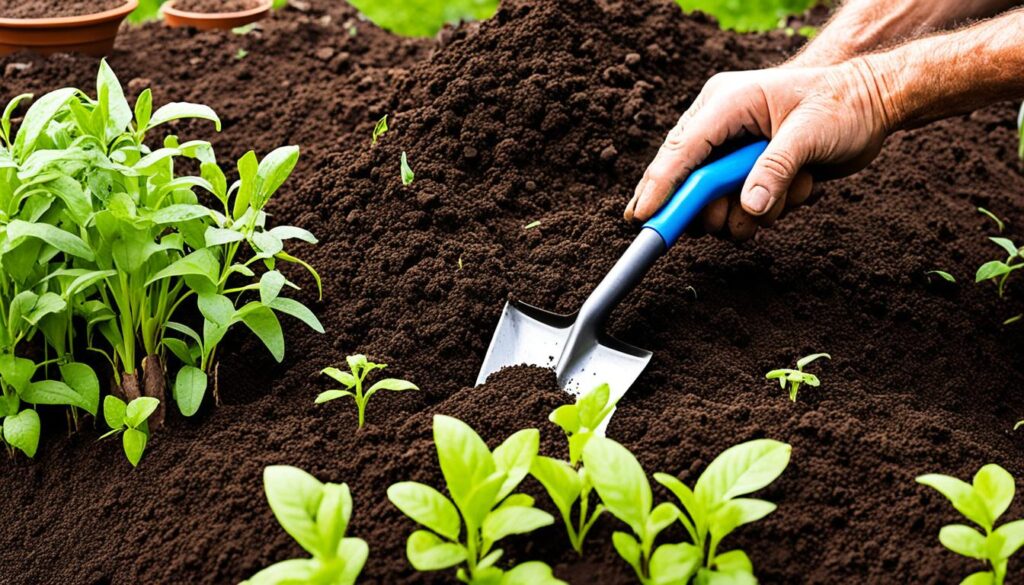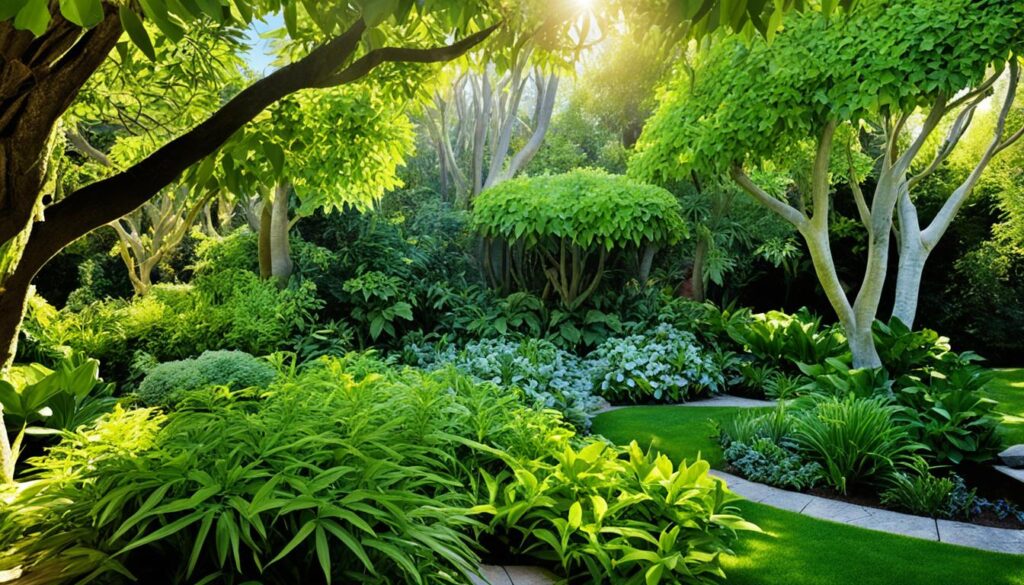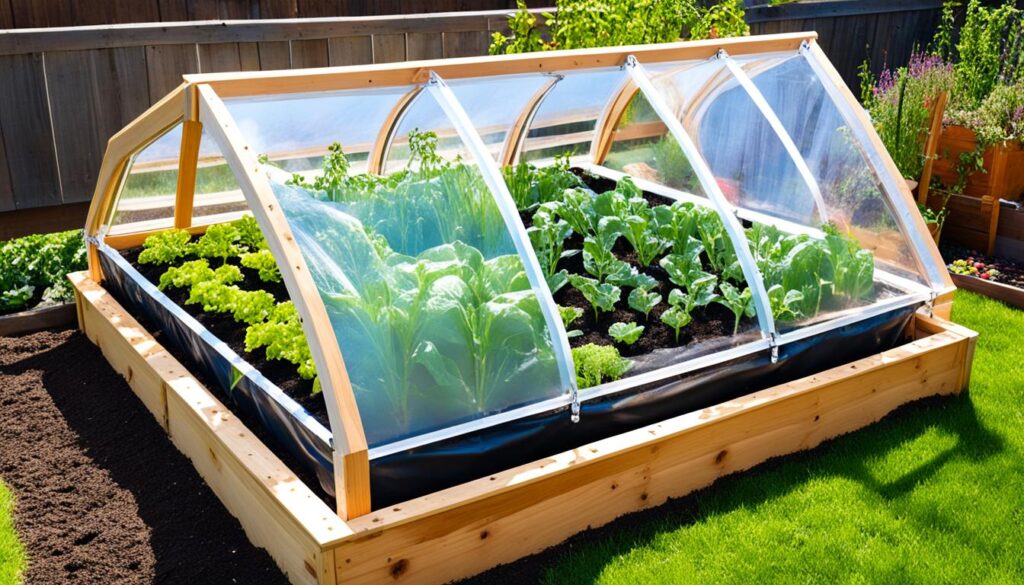Heliconia leaves are known for their lush green color and tropical beauty. However, if you notice your heliconia leaves turning brown, it can be concerning. Brown leaves can indicate a variety of issues, from fungal diseases to cultural problems. In this article, I will explore the reasons behind heliconia leaves browning and provide helpful tips to address and prevent this issue.
Key Takeaways:
- Heliconia leaves can turn brown due to fungal diseases, bacterial wilt, and cultural issues.
- Proper care practices such as watering under the leaves and avoiding water splash can prevent fungal infections.
- Bacterial wilt, caused by Pseudomonas solanacearum, is highly contagious and can lead to brown edges and leaf wilting.
- Regular inspection of rhizomes before planting can help prevent the introduction of diseases.
- Root nematodes can also cause heliconia leaf problems by feeding on the roots, resulting in yellowing, curling, and wilting.
Now, let’s delve deeper into the common causes of heliconia leaves turning brown and explore effective solutions to maintain the health and beauty of your heliconia plants.
Common Heliconia Leaf Diseases
Heliconia plants are prone to various leaf diseases, including fungal infections that result in leaf spots, discoloration, curling, and wilting. These diseases often originate from the soil and can be prevented by avoiding water splash and watering the plants under the leaves. One common disease is bacterial wilt, caused by Pseudomonas solanacearum, which is highly contagious and leads to leaf curling, wilting, and brown edges. It is crucial to avoid planting new heliconia plants in areas where this disease has occurred to prevent its spread. Regular inspection of rhizomes before planting is also essential in preventing diseases from being introduced to the plants.
![]()
Proper care and preventive measures can go a long way in ensuring the health and vitality of heliconia plants. By being aware of common heliconia leaf diseases and taking appropriate measures, such as inspecting and treating rhizomes, adopting good watering practices, and avoiding high-risk areas, gardeners can enjoy vibrant and attractive heliconia plants with thriving leaves.
Diseases Affecting Heliconia Roots and Rhizomes
Roots and rhizomes of heliconia plants are susceptible to various diseases. It is crucial to inspect rhizomes before purchasing and planting as unhealthy fragments can harbour disease. One common issue affecting heliconia roots is the presence of root nematodes. These small roundworms feed on the roots, causing swelling, lesions, and knots. As a result, the plant may experience yellow leaves, curling, wilting, and poor overall health.
Another problem that can affect heliconia roots and rhizomes is the occurrence of root and rhizome rot caused by various fungi. This condition may not become apparent until several years after planting, leading to plant decline and eventual death.
To prevent these diseases, it is recommended to wash rhizomes in a solution of bleach and water before planting. This can help eliminate any potential pathogens that may be present. Additionally, practicing good cultural measures such as providing proper drainage and avoiding overwatering can help maintain healthy roots and rhizomes.
How to Care for Heliconia Plants
Proper care is essential for keeping heliconia plants healthy and vibrant. When it comes to heliconia plant care, there are a few key factors to consider.
First, it’s important to note that heliconias thrive in warm, humid regions. Therefore, it is ideal to grow them in well-draining soil that retains moisture. This will help create the perfect environment for their growth.
Watering is another critical aspect of heliconia plant care. It is essential to provide adequate water to the plants, ensuring that you water under the leaves and avoid water splash. Overwatering can lead to root rot and brown leaf tips, while under-watering can result in dried out leaves. It’s best to strike a balance and provide a consistent water supply to keep the plants healthy.
In addition to water, heliconias also benefit from regular fertilization. Using a “Houseplant” labeled feed, apply fertilizer as per the instructions to promote optimal growth. This will ensure that your heliconia plants receive the necessary nutrients to thrive.
Placement is crucial for heliconia plants. They should be placed in a bright location with indirect sunlight, as they require a good amount of light to grow properly. Finally, it’s important to provide moderate humidity for the plants, as they thrive in humid conditions.
To summarize, for proper heliconia plant care, ensure they are grown in well-draining soil, water them adequately under the leaves, provide regular fertilization, place them in a bright location with indirect sunlight, and maintain moderate humidity.
With these care tips, your heliconia plants will stay healthy and display their vibrant leaves.
Heliconia Leaf Discoloration
Heliconia leaves can develop discoloration, appearing yellow and brown, due to fungal infections and root nematodes. Fungal diseases can cause leaf spots and yellowed edges, while root nematodes can lead to yellowing of leaves, curling, wilting, and overall poor plant health.
Regular inspection of the leaves and roots can help identify the cause of leaf discoloration and prompt appropriate treatment. It is essential to check for any signs of fungal growth, such as spots or lesions, and examine the roots for any evidence of nematode infestation or damage.
When tackling fungal infections, proper watering is crucial. Watering the soil at the base of the plant, rather than splashing water directly onto the foliage, can help prevent the spread of fungal spores. Additionally, maintaining good air circulation around the plants can reduce humidity levels, making it less favorable for fungi to thrive.
Root nematodes can be challenging to control. However, implementing hot water treatments can help disinfect the rhizomes and reduce the nematode population. It is important to follow appropriate guidelines and procedures for hot water treatments to ensure the safety of the plants.
In addition to these preventive measures, it is beneficial to maintain optimal growing conditions for heliconias. Providing adequate sunlight, proper drainage, and regular fertilization can help strengthen the plants’ overall health and make them more resilient to diseases and discoloration.
![]()
Heliconia Care Tips for Leaf Health
To keep heliconia leaves healthy, it is important to provide them with proper care. Here are some tips to promote the overall health and vitality of heliconia leaves:
Growing Conditions
- Ensure heliconia plants are grown in warm, humid regions, as they thrive in these environments.
- Plant heliconias in well-draining soil to prevent waterlogged roots, which can lead to leaf problems.
Watering
- Water under the leaves rather than from above to prevent water splash and fungal infections.
- Avoid overwatering, as this can lead to root rot and brown leaf tips.
- Do not underwater, as this can cause the leaves to dry out.
![]()
Inspection
- Regularly inspect rhizomes before planting to ensure they are free from any disease or damage.
- By carefully examining the rhizomes, you can prevent the introduction of diseased pieces.
Light and Humidity
- Provide heliconia plants with adequate light, as they require bright but indirect sunlight.
- Maintain moderate humidity levels, as this creates a suitable environment for healthy leaf growth.
Fertilization
- Regularly fertilize heliconia plants using a “Houseplant” labeled feed to provide them with essential nutrients.
- Follow the instructions on the fertilizer packaging to ensure the correct application.
By following these care tips and ensuring the proper growing conditions, watering, inspection, light and humidity, and fertilization, you can help prevent heliconia leaf problems and promote healthy and vibrant leaves.
Preventing Heliconia Leaf Problems
To ensure healthy and vibrant heliconia leaves, it is crucial to follow proper care practices and preventive measures. By taking these steps, you can prevent common issues such as heliconia leaf curling, wilting, and diseases.
Watering and Fungal Infections
One of the key contributors to heliconia leaf problems is fungal infections. Heliconia leaf curling and wilting can be signs of such infections. To prevent this, it is important to water under the leaves rather than over the top. This practice reduces water splash, which can spread fungal spores. By redirecting the water flow and avoiding direct contact with the leaves, you can effectively prevent fungal infections from taking hold.
Inspecting Rhizomes
Prior to planting heliconias, it is crucial to inspect the rhizomes carefully. This helps prevent the introduction of diseased rhizomes, which can contribute to various heliconia leaf diseases. By examining the rhizomes and ensuring they are healthy and free from signs of disease, you can protect your plants from potential leaf problems.
Light, Humidity, and Fertilization
Providing heliconias with adequate light, moderate humidity, and regular fertilization is essential for their overall health and leaf vitality. These factors promote optimal growth and make the plants less susceptible to leaf diseases. Place your heliconias in a bright location with indirect sunlight, and maintain moderate humidity levels to ensure their well-being. Regularly fertilize the plants with a suitable feed labeled for “Houseplants”.
Preventing Root Nematode Infestations
Root nematodes can be a significant source of heliconia leaf problems. These tiny roundworms feed on the roots, resulting in yellow leaves, curling, wilting, and overall poor plant health. Preventing root nematode infestations requires good air circulation and a hot water treatment for the rhizomes before planting. Ensuring your heliconias receive ample airflow and treating the rhizomes with hot water will help keep these troublesome pests at bay.
To summarize, preventing heliconia leaf problems involves practicing proper care techniques. Watering under the leaves, inspecting rhizomes, providing adequate light and humidity, regular fertilization, and taking preventive measures against root nematode infestations all contribute to healthy and vibrant heliconia leaves. By following these guidelines, you can enjoy the beauty of your heliconia plants without worrying about leaf issues.
Troubleshooting Heliconia Leaf Issues
If your heliconia leaves are experiencing problems such as curling, wilting, discoloration, or diseases, it is crucial to troubleshoot the issue to ensure the health of your plants. Here are some steps you can take to identify and address any leaf-related problems:
Inspect the Leaves, Roots, and Rhizomes
To get to the root of the problem, carefully examine the affected leaves, as well as the roots and rhizomes of your heliconia plants. Look for any signs of disease, such as spots, discoloration, or unusual growth. Pay attention to any pests or insects that may be present as well.
Follow Proper Care Practices
Proper care practices play a vital role in preventing and addressing leaf problems in heliconias. Ensure that you are watering your plants correctly by watering under the leaves and avoiding water splash, as this can help prevent fungal infections and leaf discoloration. Additionally, providing adequate light and humidity, along with regular fertilization, can contribute to the overall health of your heliconia leaves.
Seek Professional Advice
If the leaf issues persist despite your best efforts, it may be necessary to seek assistance from a gardening expert or horticulturist. They can provide expert guidance and help identify the root cause of the problem. Don’t hesitate to reach out for professional advice if needed.
By troubleshooting heliconia leaf issues promptly and following proper care practices, you can ensure that your heliconia plants thrive and display vibrant, healthy leaves.
Conclusion
In conclusion, heliconias can experience various leaf problems, including browning, discoloration, curling, and wilting. These issues can be caused by fungal infections, bacterial wilt, and cultural factors. To prevent and address these leaf problems, it is important to follow proper care practices.
Providing heliconias with adequate water, light, humidity, and fertilization is essential for their leaf health. Regularly inspecting rhizomes before planting and ensuring good air circulation can also contribute to the overall well-being of heliconia leaves. However, if issues persist despite proper care, seeking advice from a gardening expert or horticulturist is recommended.
By following these care practices and promptly addressing leaf issues, heliconias can thrive and exhibit vibrant and healthy leaves. Remember that maintaining a healthy environment and promptly addressing any signs of leaf problems are crucial for the long-term success of your heliconia plants.
